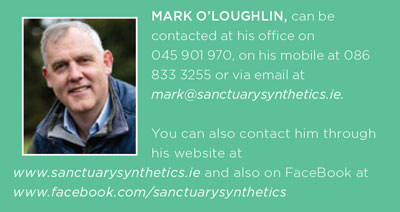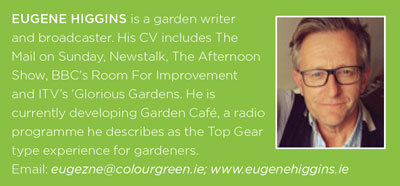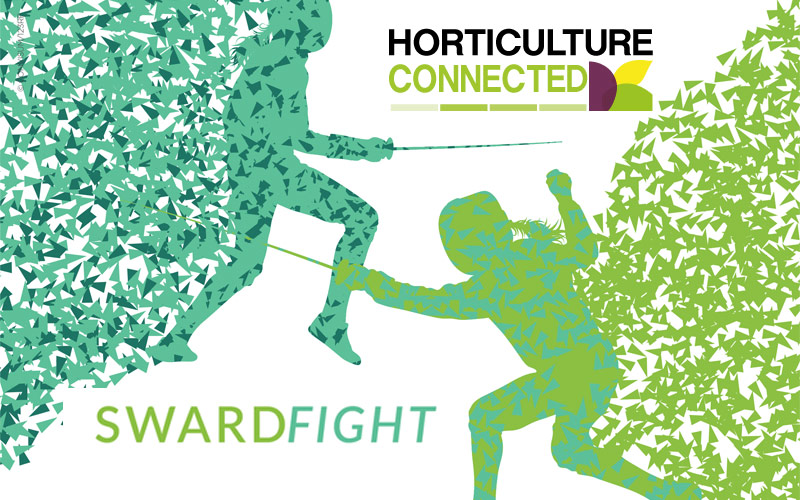We’re using a lot more artificial grass than we used to. It’s on pitches, playgrounds, balconies, rooftops, gardens, road verges and everywhere in between. It’s a phenomenon and the jury is out on whether it’s a good thing or not. To help articulate this debate in public we decided to invite two well- known and vocal garden professionals to share their side of the story.
Many thanks to Mark and Eugene for sharing their insights. We’ll be picking this debate up online afterwards, so keep an eye on horticultureConnected.ie.
NOT SO FAKE NEWS
Mark O’Loughlin, owner and operator of Sanctuary Synthetics, presents his perspective on why using synthetic grass may well be a sustainable option for the future.
“In my 17 years importing and installing synthetic grass, I’ve never tried to change anyone’s mind. In our marketing I bring its existence to people’s attention, lay out the benefits and let people vote with their feet. Fear not, concerned readers; of the 270,000 households in our Republic, we’ve only converted about 5,000 which leaves plenty left to go.
I should mention, we’ve transformed the grass for another couple of thousand trade customers including hotels, pubs, balconies, graves, and a few hundred national schools and crèches. Oh, and don’t let me forget the
24m2 we donated to Mayo mountain rescue team, which is installed half way up Croagh Patrick. A popular picnic spot when not a first aid station, I’m told.
OK, so it’s plastic versus grass. I get it. But as our
tagline says, ‘No more muck, no more mowing, no more maintenance.’ Well, very little maintenance, comparatively speaking. Think about that for a minute. No more 40 hours needed per annum with a petrol mower, giving off higher CO2 emissions than cars. No more no catalytic converters needed.
No rotten smelly cuttings dumped behind the shrubs or stewing in the wheelie bin. No pesticides required. Glyphosate anyone? No fertilisers required. And no floor cleaners either. That’s a significant reduction in chemical use and pollution over the lifespan of a lawn.
I can hear you shouting at the page, “Mark, c’mon, it’s fake.” Indeed it is, but its appearance is continually improving. My Dutch suppliers – remember they will be first to be flooded when global warming kicks in, dykes notwithstanding – have an impressively lean and waste free manufacturing process.
“Yeah, but Mark, it’s fake, it’s not a natural thing like grass.” Hmmm, a natural lawn? Now there’s an oxymoron. The beloved natural lawn is not natural at all. It’s a high maintenance, wasteful, energy and chemical hungry monoculture whose genesis lies in expressions of power and wealth over nature. Something which filtered through the English Parks Movement and into the psyche of the European populous and beyond. Lawns are the default garden element, an unnatural and labour intensive affliction. A natural lawn is a meadow.
I will make a concession; artificial grass is not biodegradable. No surprises there. But why single artificial grass out? Take a close look at modern gardens…the steel, the concrete, the reconstituted paving, the tarmac, the resin bound gravel, the pressure treated, chemical laden timbers.
Beyond the muck and the plants, very little is biodegradable, and unlike many modern artificial grasses, they’re not even recyclable. As technology improves, all artificial grass will be recyclable. More on that later.
In an ideal world we’d all be living some contemporary version of the Good Life, producing our own food and living harmoniously with our environment. We don’t live in an ideal world. We live increasingly busy lives, are time poor and have ever smaller houses with shrinking gardens. Mow the lawn? Ha, you’d be lucky to have space for one let alone the time to mow it. By the time the average homeowner flops onto their couch at the end of the week – before they are called to do kids’ drop offs, organise parties, sports events and countless other free time demands – they have no energy or inclination to mow the lawn. For most it’s easier to draw the curtains and turn their backs on the garden. From this perspective, It could be argued that lawns discourage garden use, their endlessly demanding nature a cause of resentment. We take the demands away, allowing our customers to enjoy their gardens without the hassle. I’m always amazed how many of our customers really get into gardening once the onerous mowing tasks are removed. On that note, it has been interesting to see how Bloom designers are increasingly using artificial grass in combination with excellent planting. Yes, its fake but it’s encouraging a whole new generation of people to use their gardens.
Please be aware I’m not defending Astro turf. We specialise in next generation multi-play surfaces and non-infill landscape grasses (the ones that don’t use rubber granules). I’ve always had reservations about rubber granules but that’s a debate for another day. We waste nothing. Offcuts become grave or balcony coverings. Smaller pieces become hairy green door or car mats, or samples. The rest is donated to and snapped up by Recreate Ireland to be recycled by kids and artists for arts and crafts.
I’m sure Eugene has spotted that artificial grass is a single use plastic. A by-product of the oil refining process, it is extruded onto spools of thread and woven into rolls of grass by the same machines that make carpets. Regrettably it is currently difficult to recycle. However, our grasses last twice as long as a typical Astro turf pitch, on average 20-25 years.
After that, it’s landfill. But several manufacturers have come up with grasses that are both recycled (minimum 90%) and recyclable. They are currently at a premium price. We’ve tried promoting this but so far with limited success. I think it needs government action to encourage uptake. Meanwhile, I sleep quite soundly at night. Before sitting down to write this piece I leafed through our ‘book of testimonials’. The gratitude and satisfaction of past customers and their happy children are affirmation and motivation enough for me. Why not come to Grassland, our Naas HQ, and see for yourself?” ✽

“Beyond the muck and the plants, very little is biodegradable, and unlike many modern artificial grasses, they’re not even recyclable”
The Truth, Naturally
Eugene Higgins explains why we need to turn our backs on plastic grass and embrace what comes naturally. “When I started out in landscaping in 2000, I wanted to trade under a name that would define my desire to take a more modern approach to gardening. I needed a simple phrase that would sum up the ethos of what I was about, and so Colour Green was born, a simple, short trading name and for me, a moral guideline too. I applied simple rules: no weedkiller where possible, less chemical based products, a no-no to slug pellets, and most importantly no plastic in the gardens I designed Synthetic grass was not something I ever envisaged as being part of the typical garden. For me, gardens are oases, where people and nature thrive. The idea of introducing an artificial version of grass is a garden crime of biblical proportions. The original concept of artificial grass was first devised in the early 1950s and was brought to the market by the Chemstrand Company. Interestingly, it changed name to Monsanto, and let’s face it, there are a few folks out there who see that company as having its own biblical connotations. The Ford Foundation also got involved. They had admirable aspirations in the 1960s to create year-round urban recreational zones that would allow children to play on more gentle surfaces than Tarmac and concrete. The crowning glory of this process was in 1966 when when the AstroTurf Dome in Houston USA was opened.
The future of this concept was bright and looked brilliantly futuristic, but we were naive. However, as we know, both time and reflection bring wisdom, and now plastic in all its forms is finally being recognised as a potential cause for ecological collapse. As a society, we have finally woken up and are now realising how the the fragile habitat we share with nature is being poisoned, strangled or choked into destruction. Our reckless disregard for the place we live in and for future generations is catching up with us.
Artificial grass is just part of this Doomsday story, but it’s a significant part. Synthetic grass may look and feel like the real thing. Some people simply can’t get past the fact that it’s plastic based. It is hailed by those who advocate it for
for its water-saving benefits, but artificial turf has its own environmental drawbacks. It is a petroleum-based product that creates pollution and waste in the manufacturing process. And, while it is often made partially with recycled materials, it is not biodegradable. The vast majority of artificial grass will end up in landfill after its expected lifespan of 15-20 years. I use the word ‘expected’ because most materials used in the humid climate of Ireland rarely last as long as they should. I noticed a huge amount of actual grass poking up through an artificial lawn recently. That may have been down to poor installation but it speaks to its performance in Ireland. Secretly, I was delighted.
Critics point to synthetic turf as an environmental heater.
It absorbs heat and feels hot to the touch in direct sun. Pet owners give synthetic grass mixed reviews. It does not absorb animal waste, but is permeable so liquids pass through to the ground underneath. Some suppliers have reported a surge in business in recent years, with one company seeing a year-on- year increase of 50% since 2010. If this trend continues then there is a serious threat to the country’s wildlife that relies on gardens as a valuable food source.
Artificial grass provides no benefit to wildlife. Experts say its popularity will only increase the decline in bird, insect and mammal populations across the country. Reflect on that when you make your next lawn choice. Grass lawns also matter in terms of the greenhouse effect. Plants convert carbon dioxide into oxygen. If you remove lawns, then you remove a significant carbon sink and oxygen producer. It’s negative for the environment no matter what way you cut
it, or install it for that matter. Tim Rumball, editor of Amateur Gardening magazine has been quoted as saying, “This trend could even affect the atmosphere, as plants convert carbon dioxide into oxygen and a lack of natural grassland could affect the carbon levels in the atmosphere.”
Remember, when grass grows longer it attracts insects. If you have an artificial lawn these insects will be depleted and the whole of the food network will be affected, especially birds that rely on insects for their diet. Natural lawns also provide an interface between the atmosphere and the rhizosphere. Covering over the ground slowly chokes the soil beneath. Although it is typically designed to allow water to percolate through, because there is no root action the materials below often become compacted, leaving water to be displaced. You will find bees burrowing into natural lawns, which are a mix of grass seeds. Other insects will be in there too, and also worms which are incredibly important in terms of the ability of the soil to absorb nutrients and keep it structured, so that when you have heavy rain or drought you have a soil system which can cope. In an increasingly hard landscaped world, every bit of green is vital. To hand over our lawns is an abomination. An affront to nature from its own custodians.
Did you ever lift up a piece of grass and read the ingredients? No, of course not. Me neither. I do suggest you read the ingredients of artificial grass before you propose to use it. The padding is often made of recycled tyres, which keeps them out of landfill, but the petroleum-based artificial grass materials are complex chemical creations, the products of intensive and energy hungry manufacturing processes.
Finally, I’d like you to consider Amy Griffin, a college soccer coach in Seattle, who sparked a national conversation in the USA with her suspicions about the number of current and former soccer goalkeepers who had developed blood and other rare cancers. She points to all the goalkeepers that have played on artificial grass infilled with recycled rubber tyre crumbs, and to the fact that the recycled rubber tyres in question, according to the Environmental Protection Agency, can contain heavy metals, polycyclic aromatic hydrocarbons, carbon black and other known cancer-causing chemicals.
My message to Ireland’s landscapers, gardeners and specifiers is to really consider the options. The people who will feel the impact of your decisions the most are the next generation.” ✽

